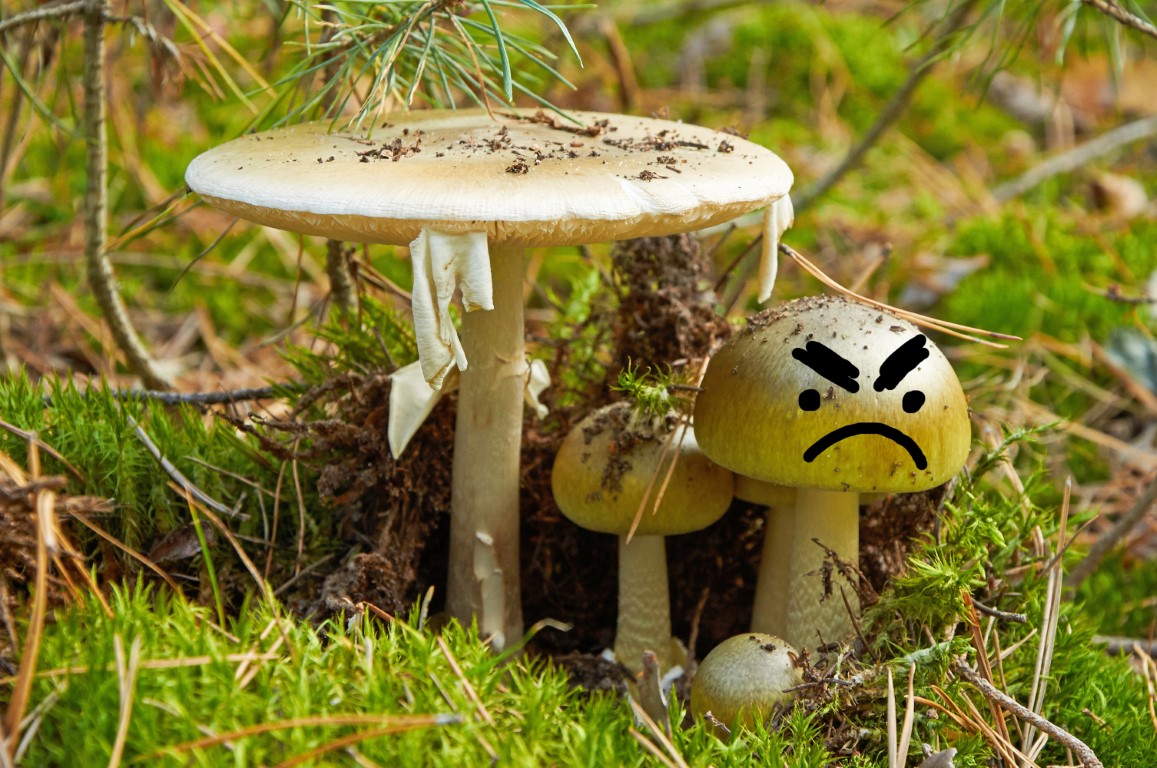
By Janis McMath, Editor-in-Chief
While your family may have been cooking the best mushrooms ever this Thanksgiving weekend, the BC Centre for Disease Control (BCCDC) was alerting British Columbians about the increasing threat of Amanita phalloides—more popularly known as “death cap mushrooms.” This species is blamed for about 90 percent of worldwide mushroom deaths and has a fatality rate of 22 percent among everyone. These mushrooms thrive in wet conditions, so the heavier the rainfall, the more calls about mushrooms the BC Drug and Poison Information Centre receives from citizens. On average, the centre receives 200 calls per year about mushroom poisonings, and about 27 percent of those calls result in “moderate, severe, or potential toxic illnesses,” according to the BCCDC. This year has mostly been on par with recent years, but this rainy June, calls were double their average at 67 calls.
Symptoms show up 8 to 12 hours after consumption and include low blood pressure, vomiting, nausea, watery diarrhea, abdominal pain, and dehydration to name a few. These fungi also are fatally deceiving, as the initial reaction can subside after 24 hours and you can feel healthy for up to 72 hours—but damage to the liver and kidneys then begins three to six days after consumption. Each mushroom only has a few thousandths of a gram of its poison (called amatoxins) but it can still easily kill a person; a visit to the emergency room is essential if this smooth-capped killer is ingested. If you or someone you care for has eaten this mushroom, bring part of the ingested mushroom if possible so that emergency workers can diagnose the problem easily.
If you’re walking in metropolitan areas, it is likely you will see some as they are regularly spotted with exotic boulevard trees. In previous years there were exclusively seen in metro areas but are now being seen in forests due to ideal conditions for spreading. If you do see these mushrooms, you can either report the invasive species to the BC government on their website for them to get rid of or you can dispose of the mushrooms yourself. To do so, BCCDC recommends obtaining a pair of gloves and grabbing a garbage bag. (While touching these mushrooms is not fatal, you can never be too careful when it comes to such a murderous plant.) Then throw them away in the garbage; avoid throwing them in the compost as they could grow and spread there. If you see death cap mushrooms in your backyard, do not mow them as you could be spreading the spores of this nasty species with your lawnmower. Ensure to remove them before mowing.
While this mushroom is native in Europe and well recognized there, it is an invasive species in North America—arriving in the roots of non-native tree species introduced in the 1960s and 1970s. These mushrooms form a symbiotic relationship (called ectomycorrhizas) with these trees. They live on the host tree’s roots for a period of 40 to 50 years before emerging to grow perennially. Even if you remove these mushrooms when you see them, they can still regrow as their mycelium (basically mushroom roots) live on the roots of the trees they partner with. Most of the trees these poisonous fungi grow alongside are introduced species—hornbeam, English oak, sweet chestnut, beech, and possibly birch and scarlet oak trees—but they have also been observed to pair with a tree native to BC, the Garry oak. While it is a problem that these mushrooms are flourishing, it is a hard problem to solve considering that the trees they grow on are well loved, huge, and increase biodiversity where they grow.
With such a
notorious reptation, you’d be curious as to why people are ingesting them. Many
cases are accidental ingestions by children (generally two thirds of mushroom calls to poison
control concern children five and under), dogs, and amateur mushroom foragers.
In fact, a trend observed in North America showed that South Asian immigrants,
specifically Hmong people, had been disproportionately affected by death cap
mushroom poisonings. The culture of foraging plus the abundance of edible
mushrooms that resemble the death cap in South Asia causes this community to
get poisoned often. Another cause is teenagers and adults mistakenly trying to
get high—in recent years, the number of adults being
poisoned by mushrooms has gone up. This spooky season, keep your eyes peeled
for these killers!
On to Cincinnati,
Janis McMath


